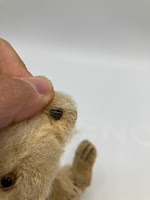Talk about hiding in plain sight! Steiffgal was checking out the latest listings on eBay to see if she could find a hidden treasure. And lo and behold, the shopping gods aligned and this rarity appeared out of nowhere! He doesn't look like much - and could be easy to miss. Check out this merry mash-up of a bear and see what makes him so distinctive from the design and marketing perspectives.
Cosy Teddy is 28 cm, unjointed, and softly stuffed. His body shape and proportions are a bit like the company's childlike Lully baby bear. Cozy Teddy is made from white dralon. His paw pads are made from pinky-peach colored dralon. He has four brown dimensional felt claws on each of his paws. His face comes to life with smaller scaled black and white cartoon eyes and a hand embroidered brown nose and mouth. This pattern of facial stitching is similar to that seen on the company's postwar Original Teddy bears. He also has a little airbrushing around his peepers to give them some depth. When he left the factory, Cosy Teddy was decorated with a blue ribbon. This guy was produced in this size only in 1964. He retains his raised script button and bits of his yellow tag as his IDs. Given his washable construction, size, and simplicity, it is quite possible he was designed a hands on plaything for kids.
This bear has two key design elements that make him quite distinctive. First, he has wool felt claws, which is most unusual in the Steiff line. A few other bears from his mid-1960s era, including Zooby the zoo bear, Cosy Nauty the polar bear, and Zipper Nauty the PJ bag, also have this detailing... but the vast majority of Steiff's cubs from all eras have embroidered or painted claws. And second, he sports round black and white plastic cartoon eyes, which are somewhat too small for his face. This configuration is also an outlier in Steiff's bear production. The only other example with this style and scale of eyes Steiffgal can think of is the company's Cosy Bruni Collar bear; he was made from 1965-1966.
Steiff clearly had big plans for Cosy Teddy, as he was the "cover bear" for its 1964 "New Models" catalog. You can see that cover shot here on the left. Like Cosy Teddy, this four page catalog introduced a significant collection of new editions made from dralon materials. This publication is also very interesting because it debuted a number of items that were only produced for a year or so. Steiffgal refers to these now hard to find treasures as "One-derfuls" to note their single year appearance in the line. Cosy Teddy is one of these 1964 "One-derfuls"; others pictured in this brochure include Reinhold the Rhino, Loopy the Wolf, Zipper Cockie, and Sneba the Snowman puppet. Today, many of these rarities top enthusiasts' wish lists given how few were produced over a very short period of time.
Steiffgal hopes this discussion on Cosy Teddy and his discovery has added a soft spot to your day.
















